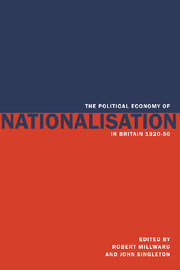Book contents
- Frontmatter
- Contents
- List of tables
- List of contributors
- Preface
- I Government and industry 1920–50
- II Case studies of industry organisation, performance and nationalisation
- 3 The coal industry: images and realities on the road to nationalisation
- 4 The changing role of government in British civil air transport 1919–49
- 5 The motor vehicle industry
- 6 The railway companies and the nationalisation issue 1920–50
- 7 The motives for gas nationalisation: practicality or ideology?
- 8 Public ownership and the British arms industry 1920–50
- 9 The water industry 1900–51: a failure of public policy?
- 10 Debating the nationalisation of the cotton industry, 1918–50
- III Government and the process of industrial change in the 1940s
- IV Review and Conclusions
- Index
9 - The water industry 1900–51: a failure of public policy?
Published online by Cambridge University Press: 07 May 2010
- Frontmatter
- Contents
- List of tables
- List of contributors
- Preface
- I Government and industry 1920–50
- II Case studies of industry organisation, performance and nationalisation
- 3 The coal industry: images and realities on the road to nationalisation
- 4 The changing role of government in British civil air transport 1919–49
- 5 The motor vehicle industry
- 6 The railway companies and the nationalisation issue 1920–50
- 7 The motives for gas nationalisation: practicality or ideology?
- 8 Public ownership and the British arms industry 1920–50
- 9 The water industry 1900–51: a failure of public policy?
- 10 Debating the nationalisation of the cotton industry, 1918–50
- III Government and the process of industrial change in the 1940s
- IV Review and Conclusions
- Index
Summary
The economic and management problems of water resource development
The management and use of water are governed by the water cycle. This is initiated for present purposes when rain water replenishes upland gathering grounds and concludes when estuaries or other outlets release water to the sea. The water industry performs three different sets of functions within the water cycle. It supplies consumers with water. Secondly after use, effluent is returned to the cycle having been more or less purified at treatment works. Thirdly there are river conservancy tasks, touching upon the control, conservation and release of water, flood control and land drainage. All these functions interact. Sewage disposal may pollute sources used for domestic consumption; abstraction of water from a river may effect its capacity to dilute and carry effluent, and influences the interests of many other users, such as industry, canals and fisheries. Physical interdependencies have important implications for the management of water resources. From the time of Edwin Chad wick it has been argued that all these functions should be carried out by integrated riverbasin based undertakings. These would be able to achieve an efficient and coordinated use of water resources and resolve the numerous human conflicts which arise in that connection.
Throughout the first half of the twentieth century, however, the water industry remained fragmented both across and within the three sectors. Water supply and sewage works were too small and numerous from the point of view of technical efficiency. Table 9.1 traces trends in the number of water supply undertakings.
- Type
- Chapter
- Information
- The Political Economy of Nationalisation in Britain, 1920–1950 , pp. 189 - 211Publisher: Cambridge University PressPrint publication year: 1995
- 2
- Cited by



